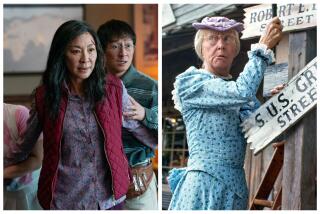Commentary : ‘thirtysomething’ Was Vintage TV
- Share via
“A major breakthrough was made in helping to relieve headache pain,” joked Jay Leno on “The Tonight Show” not long ago. “ABC can celed ‘thirtysomething.’ ”
Leno was never “thirtysomething’s” biggest fan. When the producers killed off the character of Gary (played by Peter Horton) earlier this season, Leno cracked, “Well, one down, six to go!” More recently, Leno explained his objections: “It was a whiny show. All they did was whine on that show.”
It was whiny, and now that it’s gone there will probably be massive outbreaks of whining among its millions of fans. I must admit I was never one of them, but I mourn it nonetheless. It had class.
On May 28, ABC aired the last first-run episode of “thirtysomething,” and the show went out like a fine white whine.
Mopey Michael (Ken Olin), temporarily unemployed, almost left wan wife Hope (Mel Harris) to start up a new business in Los Angeles with freaky friend Elliot (Timothy Busfield) but, in the end, rushed back home to reconcile. The episode ended with Michael clinging to Hope as their two children played on the kitchen floor.
So now they can get on with their lives. And now we can get on with ours. Or, as the case may be, our lives can get on with us.
There aren’t many contemporary domestic problems that weren’t explored, or beaten to death, on “thirtysomething.” The drama series was about a coven of baby boomers having a very hard time adjusting to the kinds of things previous generations took in stride.
In four years on the air, the “thirtysomething” kids suffered from anomie and ennui and terminal confusion. They all wondered who they were and they all endeavored to take charge of their lives.
The show brandished, even flaunted, its own brand of political correctness. It was very chic , very trendy, very New Age, very save-the-whales, very Honda Civic, very frozen yogurt, very Kevin Costner, very hardwood floors, very Evian water, very NPR, very help-the-homeless.
All the “thirtysomething” folk fretted a lot about selling out, worries that probably reflect those of producers Edward Zwick and Marshall Herskovitz, the two over-educated smarty pantses who created the show and whose names were among the eight credited with writing the final episode.
Often the problems that caused such anguish and soul searching for the characters seemed trivial and petty, and their Angst merely self-indulgent. But occasionally, some true life-and-death matters arose, like this season and last when Elliot’s wife Nancy, movingly played by Patricia Wettig, developed ovarian cancer.
Episodes that dealt with her reaction to the disease, and the reactions of those around her, were probably the best and most substantial “thirtysomethings” ever done.
One could go on and on with complaints, but even the fact that “thirtysomething” drove some people up the wall is kind of a tribute.
With “thirtysomething,” both detractors and fans were passionate, testifying to the show’s strength of character. The series had its own style, its own outlook, and fresh, distinctive touches that set it apart.
Sometimes it made you want to scream. And sometimes it made you want to yawn. But it always stood out from the crowd. Network TV is duller, and poorer, every time it loses a show like this.
More to Read
The complete guide to home viewing
Get Screen Gab for everything about the TV shows and streaming movies everyone’s talking about.
You may occasionally receive promotional content from the Los Angeles Times.





